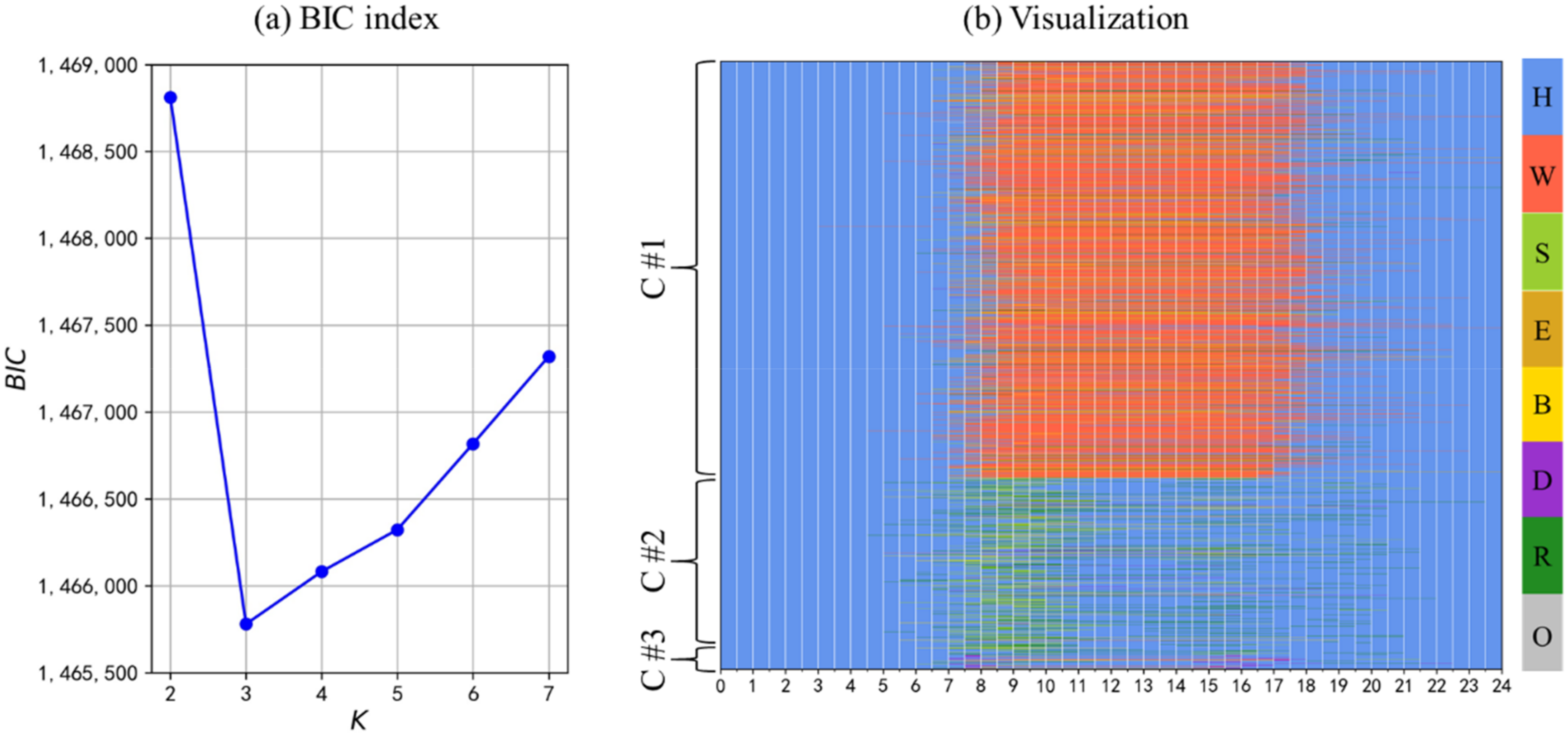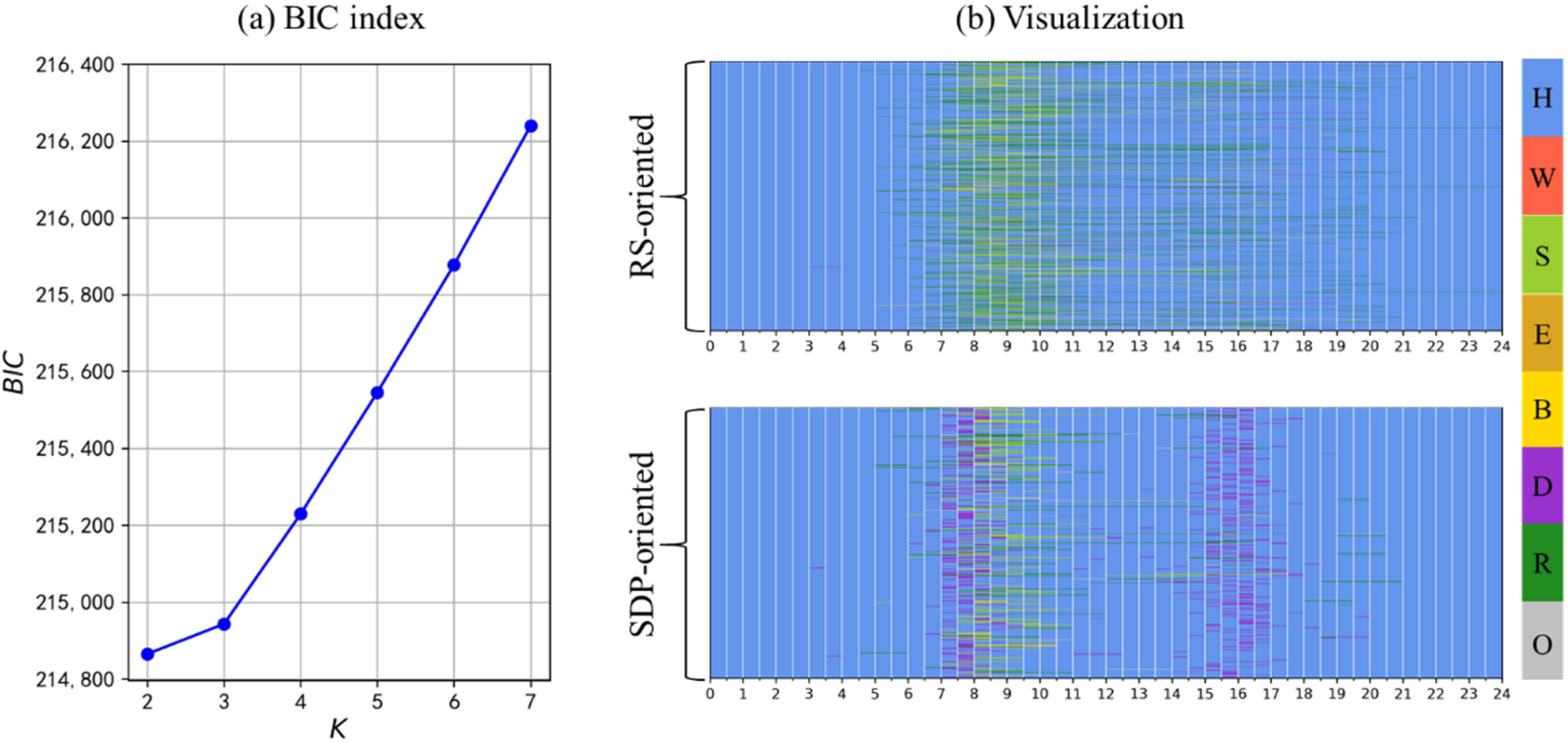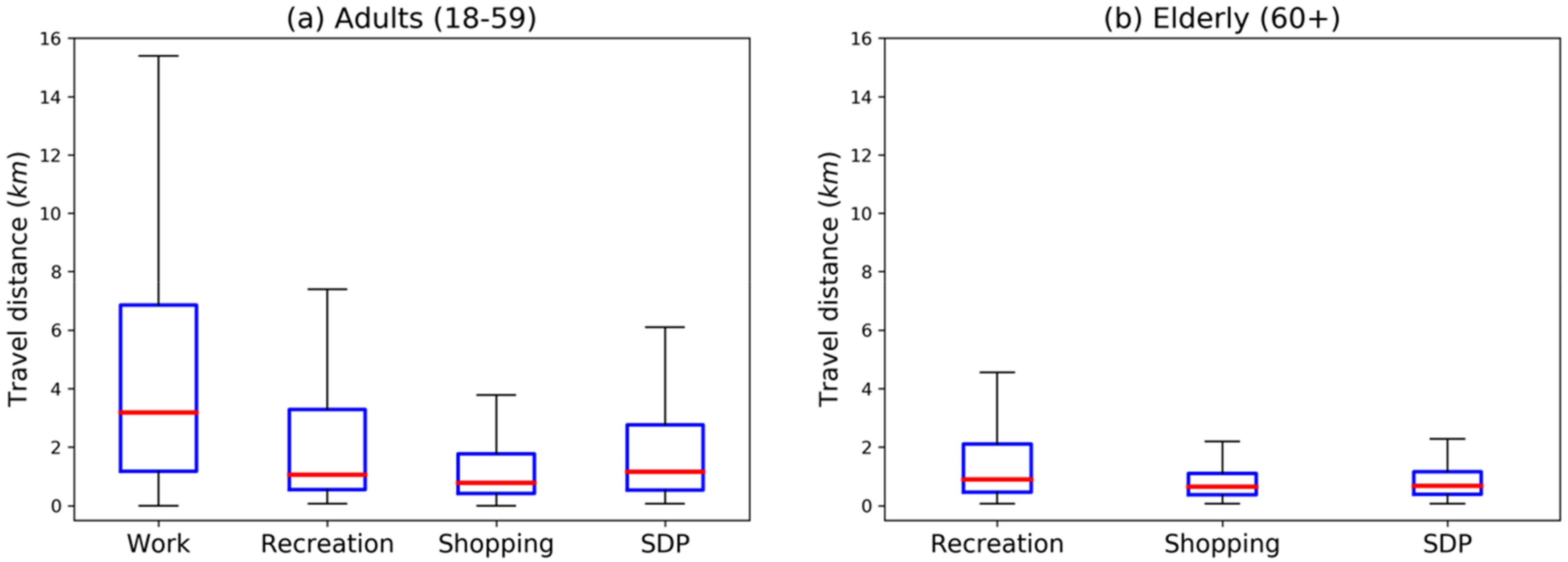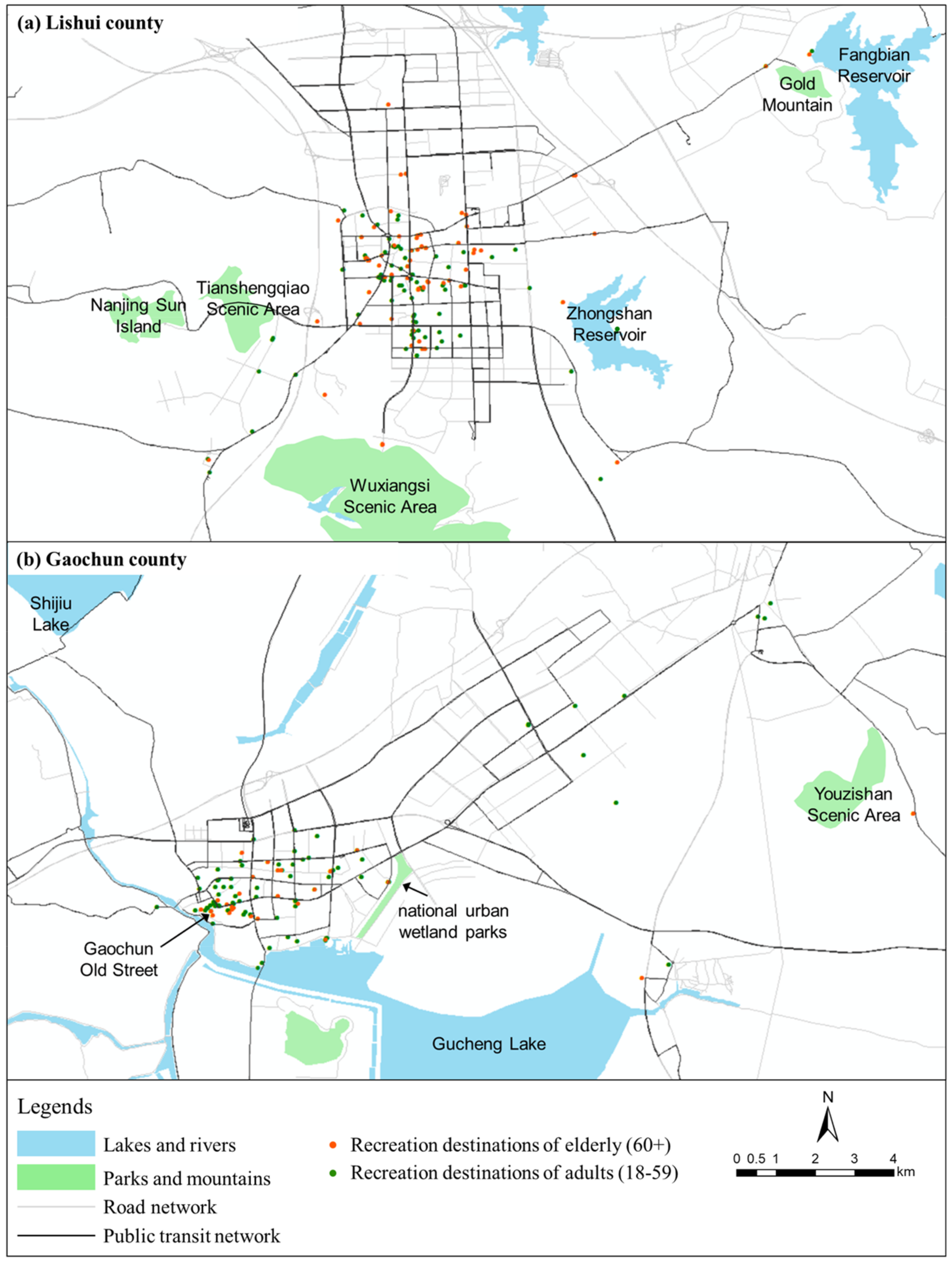Transport for the Elderly: Activity Patterns, Mode Choices, and Spatiotemporal Constraints
Abstract
:1. Introduction
2. Literature Review
2.1. Travel Needs and Behaviors of the Elderly
2.2. Activity Pattern Clustering Techniques
3. Materials and Methods
3.1. Data
3.2. Activity Chain Segmentation
3.3. Clustering Using MC-Based Mixture Model
4. Results
4.1. Categorization of Activity Patterns
4.2. Summary of Activity Patterns Across Two Categories
4.3. Transport Mode Choices
5. Discussion
5.1. School Drop-Off/Pick-Up Safety
5.2. Bus Services for Recreational Activities
6. Conclusions
Author Contributions
Funding
Acknowledgments
Conflicts of Interest
References
- Uhlenberg, P. International Handbook of Population Aging; Springer Science & Business Media: Berlin/Heidelberg, Germany, 2009; Volume 1. [Google Scholar]
- Gell, N.M.; Rosenberg, D.E.; Carlson, J.; Kerr, J.; Belza, B. Built environment attributes related to GPS measured active trips in mid-life and older adults with mobility disabilities. Disabil. Health J. 2015, 8, 290–295. [Google Scholar] [CrossRef] [PubMed] [Green Version]
- Feng, J. The influence of built environment on travel behavior of the elderly in urban China. Transp. Res. Part D Transp. Environ. 2017, 52, 619–633. [Google Scholar] [CrossRef]
- Feng, J.; Dijst, M.; Wissink, B.; Prillwitz, J. The impacts of household structure on the travel behaviour of seniors and young parents in China. J. Transp. Geogr. 2013, 30, 117–126. [Google Scholar] [CrossRef]
- Kim, S. Assessing mobility in an aging society: Personal and built environment factors associated with older people’s subjective transportation deficiency in the US. Transp. Res. Part F Traffic Psychol. Behav. 2011, 14, 422–429. [Google Scholar] [CrossRef]
- Horner, M.W.; Duncan, M.D.; Wood, B.S.; Valdez-Torres, Y.; Stansbury, C. Do aging populations have differential accessibility to activities? Analyzing the spatial structure of social, professional, and business opportunities. Travel Behav. Soc. 2015, 2, 182–191. [Google Scholar] [CrossRef]
- Zhang, J.; Fujiwara, A. Representing household time allocation behavior by endogenously incorporating diverse intra-household interactions: A case study in the context of elderly couples. Transp. Res. Part B Methodol. 2006, 40, 54–74. [Google Scholar] [CrossRef]
- Kim, S.; Ulfarsson, G.F. Travel mode choice of the elderly: Effects of personal, household, neighborhood, and trip characteristics. Transp. Res. Rec. 2004, 1894, 117–126. [Google Scholar] [CrossRef]
- Zhang, Z.; Baohua, M.A.O.; Mingjun, L.I.U.; Jinchuan, C.H.E.N.; Jifu, G.U.O. Analysis of travel characteristics of elders in Beijing. J. Transp. Syst. Eng. Inf. Technol. 2007, 7, 11–20. [Google Scholar] [CrossRef]
- Hahn, J.S.; Kim, H.C.; Kim, J.K.; Ulfarsson, G.F. Trip making of older adults in Seoul: Differences in effects of personal and household characteristics by age group and trip purpose. J. Transp. Geogr. 2016, 57, 55–62. [Google Scholar] [CrossRef]
- Collia, D.V.; Sharp, J.; Giesbrecht, L. The 2001 national household travel survey: A look into the travel patterns of older Americans. J. Saf. Res. 2003, 34, 461–470. [Google Scholar] [CrossRef]
- Rosenbloom, S. The mobility needs of older Americans. In Taking the High Road: A Transportation Agenda for Strengthening Metropolitan Areas; Katz, B., Puentes, R., Eds.; Brookings Press: Washington, DC, USA, 2004. [Google Scholar]
- Newbold, K.B.; Scott, D.M.; Spinney, J.E.; Kanaroglou, P.; Páez, A. Travel behavior within Canada’s older population: A cohort analysis. J. Transp. Geogr. 2005, 13, 340–351. [Google Scholar] [CrossRef]
- Truong, L.T.; Somenahalli, S.V. Exploring frequency of public transport use among older adults: A study in Adelaide, Australia. Travel Behav. Soc. 2015, 2, 148–155. [Google Scholar] [CrossRef]
- Tacken, M. Mobility of the elderly in time and space in the Netherlands: An analysis of the Dutch National Travel Survey. Transportation 1998, 25, 379–393. [Google Scholar] [CrossRef]
- Banister, D.; Bowling, A. Quality of life for the elderly: The transport dimension. Transp. Policy 2004, 11, 105–115. [Google Scholar] [CrossRef]
- Davey, J.A. Older people and transport: Coping without a car. Ageing Soc. 2007, 27, 49. [Google Scholar] [CrossRef]
- Siren, A.; Hakamies-Blomqvist, L. Private car as the grand equaliser? Demographic factors and mobility in Finnish men and women aged 65+. Transp. Res. Part F Traffic Psychol. Behav. 2004, 7, 107–118. [Google Scholar] [CrossRef]
- Schmöcker, J.D.; Quddus, M.A.; Noland, R.B.; Bell, M.G. Mode choice of older and disabled people: A case study of shopping trips in London. J. Transp. Geogr. 2008, 16, 257–267. [Google Scholar] [CrossRef] [Green Version]
- Laverty, A.A.; Millett, C. Potential impacts of subsidised bus travel for older people. J. Transp. Health 2015, 2, 32–34. [Google Scholar] [CrossRef]
- Saxena, A.; Prasad, M.; Gupta, A.; Bharill, N.; Patel, O.P.; Tiwari, A.; Er, M.J.; Ding, W.; Lin, C.-T. A review of clustering techniques and developments. Neurocomputing 2017, 267, 664–681. [Google Scholar] [CrossRef] [Green Version]
- Xu, R.; Wunsch, D.C. Clustering algorithms in biomedical research: A review. IEEE Rev. Biomed. Eng. 2010, 3, 120–154. [Google Scholar] [CrossRef]
- McNicholas, P.D. Model-based clustering. J. Classif. 2016, 33, 331–373. [Google Scholar] [CrossRef] [Green Version]
- Mohamed, K.; Côme, E.; Oukhellou, L.; Verleysen, M. Clustering smart card data for urban mobility analysis. IEEE Trans. Intell. Transp. Syst. 2016, 18, 712–728. [Google Scholar]
- Joh, C.H.; Arentze, T.; Timmermans, H. Pattern recognition in complex activity travel patterns: Comparison of Euclidean distance, signal-processing theoretical, and multidimensional sequence alignment methods. Transp. Res. Rec. 2001, 1752, 16–22. [Google Scholar] [CrossRef]
- Jiang, S.; Ferreira, J.; González, M.C. Clustering daily patterns of human activities in the city. Data Min. Knowl. Discov. 2012, 25, 478–510. [Google Scholar] [CrossRef] [Green Version]
- Goulet-Langlois, G.; Koutsopoulos, H.N.; Zhao, J. Inferring patterns in the multi-week activity sequences of public transport users. Transp. Res. Part C Emerg. Technol. 2016, 64, 1–16. [Google Scholar] [CrossRef] [Green Version]
- Wang, Y.; Qin, K.; Chen, Y.; Zhao, P. Detecting anomalous trajectories and behavior patterns using hierarchical clustering from taxi GPS data. ISPRS Int. J. Geo-Inf. 2018, 7, 25. [Google Scholar] [CrossRef] [Green Version]
- Zhai, W.; Bai, X.; Peng, Z.R.; Gu, C. From edit distance to augmented space-time-weighted edit distance: Detecting and clustering patterns of human activities in Puget Sound region. J. Transp. Geogr. 2019, 78, 41–55. [Google Scholar] [CrossRef]
- Melnykov, V. ClickClust: An R package for model-based clustering of categorical sequences. J. Stat. Softw. 2016, 74, 1–34. [Google Scholar] [CrossRef] [Green Version]
- Melnykov, V. Challenges in model-based clustering. Wiley Interdiscip. Rev. Comput. Stat. 2013, 5, 135–148. [Google Scholar] [CrossRef]
- Bouveyron, C.; Brunet-Saumard, C. Model-based clustering of high-dimensional data: A review. Comput. Stat. Data Anal. 2014, 71, 52–78. [Google Scholar] [CrossRef] [Green Version]
- Pamminger, C.; Frühwirth-Schnatter, S. Model-based clustering of categorical time series. Bayesian Anal. 2010, 5, 345–368. [Google Scholar] [CrossRef]








| No. | Symbols | Combined Categories | Original Categories in Survey |
|---|---|---|---|
| 1 | H | Home | Go home (owned or leased) |
| 2 | W | Work | Go to work Return to work |
| 3 | S | Shopping | Buy goods (groceries, clothes, appliances) Buy meals |
| 4 | E | Education and training | Attend school as a student Attend training or course class |
| 5 | B | Business/obligations | Attend business meeting Agricultural/fishing events Use professional services Other business |
| 6 | D | Drop-off/pickup | Drop-off/pickup someone Accompany kids to school/training class |
| 7 | R | Recreational/social | Recreational activities Social and community Visit public places Visit friends, relatives, patients Go for a walk |
| 8 | O | Others | Something else |
Publisher’s Note: MDPI stays neutral with regard to jurisdictional claims in published maps and institutional affiliations. |
© 2020 by the authors. Licensee MDPI, Basel, Switzerland. This article is an open access article distributed under the terms and conditions of the Creative Commons Attribution (CC BY) license (http://creativecommons.org/licenses/by/4.0/).
Share and Cite
Zhou, Y.; Yuan, Q.; Yang, C. Transport for the Elderly: Activity Patterns, Mode Choices, and Spatiotemporal Constraints. Sustainability 2020, 12, 10024. https://doi.org/10.3390/su122310024
Zhou Y, Yuan Q, Yang C. Transport for the Elderly: Activity Patterns, Mode Choices, and Spatiotemporal Constraints. Sustainability. 2020; 12(23):10024. https://doi.org/10.3390/su122310024
Chicago/Turabian StyleZhou, Yang, Quan Yuan, and Chao Yang. 2020. "Transport for the Elderly: Activity Patterns, Mode Choices, and Spatiotemporal Constraints" Sustainability 12, no. 23: 10024. https://doi.org/10.3390/su122310024





